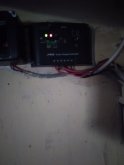I find it helpful to do the math, so people can plug in their own numbers to suit their needs. In general, for lead-acid batteries, my rule of thumb is that you have three choices for charging rates, low (0.05C), medium (0.1C), and high (0.15C) where C is the capacity in amphours (your's being 75AH). In comparison, at a low rate, it might take 2-3 days to fully charge a depleted battery. At medium, 1-2 days, and at high, less than 1 day.
You multiply the charging rate by your system voltage, in this case, 12V. I always include a fudge factor to compensate that panels almost never put out their rated current. I like to use a fudge factor of 1.2.
So for a minimal charge level the math works out to BAH x CR x V x FF =panel watts, or in your case 75AH x 0.05 x 12V x 1.2 =54watts. As you can see from the numbers, your 40W panel is below minimal in whats acceptable. Expect it to take more than 3 days to charge a depleted battery
For a medium charge the numbers are: 75AH x 0.1 x 12V x 1.2= 108Watts. For High they are: 75AH x 0.15 x 12V x 1.2 = 162Watts.
So, the numbers are saying to replace your 40W panel with one of 100-160watts. I've used this formula for years now, and I have never had a depleted battery.



